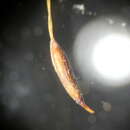Comments
provided by eFloras
Rhizoidal tubers were first reported for Ditrichum heteromallum by S. Risse (1985) from European material and have also been noted in Japanese material by H. Deguchi and T. Matsui (1986). They have the appearance of short filaments with swollen, contorted rhizoid cells. Ditrichum zonatum (Bridel) Kindberg, including the var. scabrifolium Dixon, appears to be only a small form of D. heteromallum with shorter, appressed leaves that are often more 2-stratose, especially near the base, and leaf cells that are sometimes papillose at the ends. We have not seen specimens that support the Wisconsin report by F. Bowers and S. Freckman (1979) and believe the record to be dubious.
- license
- cc-by-nc-sa-3.0
- copyright
- Missouri Botanical Garden, 4344 Shaw Boulevard, St. Louis, MO, 63110 USA
Description
provided by eFloras
Plants small, up to 1.0 cm high, yellowish green, in loose tufts. Stems erect, simple. Leaves slightly homomallous, appressed when dry, erect-patent when moist, lanceolate, 2.0–3.5 mm long, abruptly narrowed from an ovate base to a long, setaceous acumen; margins plane and entire; costa stout, percurrent to short-excurrent, filling almost the entire subula; cells elongate throughout, rectangular to linear, 20–40 µm × 3–5 µm, rather thin-walled. Dioicous. Perichaetial leaves larger than the upper stem leaves, sheathing at base. Setae straight, 1.5–2.0 cm long, reddish brown; capsules erect, cylindric, nearly symmetric, ca. 2 mm × 0.3–0.4 mm, reddish brown, slightly contracted below the mouth; opercula short conic-rostrate; annuli in 2 rows of large, thick-walled cells; peristome teeth linear, 0.25–0.30 mm long, divided nearly to the base, whitish yellow, irregularly papillose. Spores 10–12 µm in diameter, yellow, nearly smooth.
- license
- cc-by-nc-sa-3.0
- copyright
- Missouri Botanical Garden, 4344 Shaw Boulevard, St. Louis, MO, 63110 USA
Description
provided by eFloras
Plants in loose to dense tufts, yellowish green. Stems to 1 cm, simple, seldom branched. Leaves 1.5-3 mm, erect-spreading, sometimes slightly secund, from an ovate to oblong base tapering gradually to a long channelled subula, lamina 2-stratose distally; margins plane, 1-stratose proximally, 2-stratose in the middle to distal parts; costa broad, occupying most of the subula, in section with a distinct abaxial and poorly developed adaxial stereid band; cells of subula and distal lamina elongate-rectangular, longer in the leaf base, smooth or sometimes papillose at both ends, especially near leaf apices. Specialized asexual reproduction by rarely produced rhizoidal tubers. Sexual condition dioicous. Seta reddish brown, 1-2.5 mm. Capsule erect, reddish brown, oblong to cylindric, symmetric, 0.5-1.5 mm; peristome teeth pale orange, about 300 µm, lightly papillose; operculum conic-rostrate, blunt, 0.4-0.5 mm. Spores 10-15 µm, finely papillose.
- license
- cc-by-nc-sa-3.0
- copyright
- Missouri Botanical Garden, 4344 Shaw Boulevard, St. Louis, MO, 63110 USA
Distribution
provided by eFloras
Distribution: China, India, Korea, Japan, Europe, Alaska, and North and South America.
- license
- cc-by-nc-sa-3.0
- copyright
- Missouri Botanical Garden, 4344 Shaw Boulevard, St. Louis, MO, 63110 USA
Habitat
provided by eFloras
Habitat: on soil or rocks.
- license
- cc-by-nc-sa-3.0
- copyright
- Missouri Botanical Garden, 4344 Shaw Boulevard, St. Louis, MO, 63110 USA
Synonym
provided by eFloras
Ditrichum homomallum (Hedw.) Hampe, Flora 50: 182. 1867. Didymodon homomallus Hedw., Sp. Musc. Frond. 105. 1801.
Ditrichum subtortile Card., Bull. Herb. Boiss., sér. 2, 7: 716. 1907.
- license
- cc-by-nc-sa-3.0
- copyright
- Missouri Botanical Garden, 4344 Shaw Boulevard, St. Louis, MO, 63110 USA
Synonym
provided by eFloras
Weissia heteromalla Hedwig, Sp. Musc. Frond., 71. 1801; Didymodon homomallus Hedwig; Ditrichum homomallum (Hedwig) Hampe; D. zonatum (Bridel) Kindberg; D. zonatum var. scabrifolium Dixon
- license
- cc-by-nc-sa-3.0
- copyright
- Missouri Botanical Garden, 4344 Shaw Boulevard, St. Louis, MO, 63110 USA
Comprehensive Description
provided by North American Flora
Ditrichum heteromallum (Hedw.) E. G. Britton
Weisia heleromalla Hedw. Descr. 1: 22. 1787.
Didymodon homomallus Hedw. Sp. Muse. 105. 1801.
Trichoslomum homomallum Bruch & Schimp. in B.S.G. Bryol. Eur. (18-20:) Trichost. 16. 1843.
Ditrichum homomallum Hampe. Flora 50: 182. 1867.
Trichoslomum heteromallum Lindb.; Aust. Bull. Torrey Club 6: 74. 1876.
Plants gregarious or rarely cespitose; stems usually simple, only 5-10 mm. high, rarely branching and taller, 4-5 cm. high, with red tomentum: leaves spreading, twisted or secund when dry, 1-2 mm., rarely 3 mm. long, the apex subulate from a short ovate base; margins entire or rarely subserrulate at the apex, not revolute; costa broad, flat, not channelled, excurrent into the long slender awn, toothed at the apex; lower cells narrow, linear, not much thickened, the upper ones rectangular; perichaetial leaves clasping at the base, abruptly longsubulate. Dioicous: seta 1-2.5 cm. long, dark-red; capsule also dark-red, erect, cylindric, becoming ovoid, 1-1.5 mm. long; walls with small irregular hexagonal cells; lid small, conic, blunt, the cells straight, small, hexagonal,' the border dentate; annulus large, double, of two rows of cells, falling in fragments; mouth small, bordered by darker flaring cells; peristome long and slender, fugacious, with a short basal membrane; teeth bifid to the base or united below at the joints, rarely not divided, red or brown, smooth or slightly roughened: spores yellow, smooth, 12-14 ^ in diameter, maturing in fall and winter.
Type locality: Saxony, Germany.
Distribution: Rare in mountain regions of North America from the west side of the Rocky Mountains to Alaska; leported from the White Mountains, New Hampshire; also in Europe.
- bibliographic citation
- Albert LeRoy Andrews, Elizabeth Gertrude Britton, Julia Titus Emerson. 1961. SPHAGNALES-BRYALES; SPHAGNACEAE; ANDREAEACEAE, ARCHIDIACEAE, BRUCHIACEAE, DITRICHACEAE, BRYOXIPHIACEAE, SELIGERIACEAE. North American flora. vol 15(1). New York Botanical Garden, New York, NY

